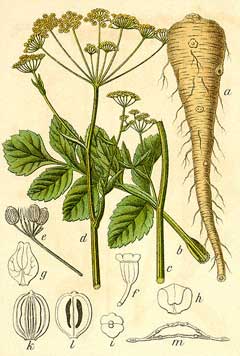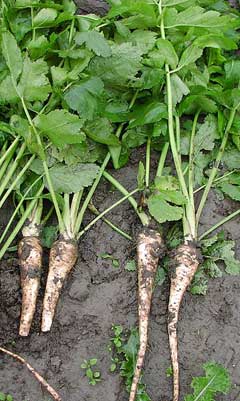 |
|
http://commons.wikimedia.org/wiki/File:Pastinake-2.jpg |
 |
| http://commons.wikimedia.org/wiki/User:Goldlocki |
Translate this page:
Summary
Physical Characteristics

 Pastinaca sativa is a BIENNIAL growing to 1 m (3ft 3in) by 0.3 m (1ft).
Pastinaca sativa is a BIENNIAL growing to 1 m (3ft 3in) by 0.3 m (1ft).
See above for USDA hardiness. It is hardy to UK zone 5 and is not frost tender. It is in flower from July to August, and the seeds ripen from August to September. The species is hermaphrodite (has both male and female organs) and is pollinated by Insects. The plant is self-fertile.
Suitable for: light (sandy), medium (loamy) and heavy (clay) soils and prefers well-drained soil. Suitable pH: mildly acid, neutral and basic (mildly alkaline) soils. It can grow in semi-shade (light woodland) or no shade. It prefers moist soil.
UK Hardiness Map
US Hardiness Map
Synonyms
Peucedanum sativum.
Plant Habitats
Cultivated Beds;
Edible Uses
Edible Parts: Leaves Root Seed Shoots
Edible Uses: Condiment
Root - raw or cooked[2, 4, 5, 9, 27, 183]. When well grown, the cooked root has a very tender texture, though it is rather chewy raw[K]. It is best harvested after there have been some autumn frosts because it will have developed a sweeter flavour[61]. The root is delicious baked, it can also be used in soups etc and can be added to cakes, pies and puddings[183]. Leaves and young shoots - cooked with other greens as a vegetable or added to soups etc[9, 183]. Used in early spring[9]. The seed is used as a condiment[9]. Similar in taste to dill[183].
References More on Edible Uses
Medicinal Uses
Plants For A Future can not take any responsibility for any adverse effects from the use of plants. Always seek advice from a professional before using a plant medicinally.
Poultice Women's complaints
A tea made from the roots has been used in the treatment of women's complaints[222]. A poultice of the roots has been applied to inflammations and sores[222]. The root contains xanthotoxin, which is used in the treatment of psoriasis and vitiligo[222]. Xanthotoxin is the substance that causes photosensitivity (see note above on toxicity)[222].
References More on Medicinal Uses
The Bookshop: Edible Plant Books
Our Latest books on Perennial Plants For Food Forests and Permaculture Gardens in paperback or digital formats.

Edible Tropical Plants
Food Forest Plants for Hotter Conditions: 250+ Plants For Tropical Food Forests & Permaculture Gardens.
More

Edible Temperate Plants
Plants for Your Food Forest: 500 Plants for Temperate Food Forests & Permaculture Gardens.
More

More Books
PFAF have eight books available in paperback and digital formats. Browse the shop for more information.
Shop Now
Other Uses
Insecticide Repellent
The leaves and roots are used to make an insect spray[20]. Roughly chop the leaves and roots, put them in a basin with enough water to cover, leave them overnight then strain and use as an insecticide against aphids and red spider mite[201].
Special Uses
Food Forest
References More on Other Uses
Cultivation details
Succeeds in most ordinary well-drained soils[16]. Requires an open situation[37]. Prefers a deep rich soil that is not too stiff[1]. The parsnip is often cultivated in the temperate zone for its edible root, there are a number of named varieties[46, 183, 200]. Normally cultivated as a winter root crop, some cultivars are faster to mature and can be available in late summer[200]. The roots are very frost hardy and can be left in the ground to be harvested as required, though they can also be lifted in the autumn and stored for a few months[200]. The flowers are very attractive to hover flies and predatory wasps[201]. Plants have very few insect pests, though they are sometimes attacked by carrot root fly[201]. Growing onions with the parsnips can reduce the damage[201]. Roots of the wild form can quite quickly be increased in size by selective breeding and good cultivation, it is possible to obtain good sized roots in only 6 years. In garden design, as well as the above-ground architecture of a plant, root structure considerations help in choosing plants that work together for their optimal soil requirements including nutrients and water. The root pattern is fleshy. Thick or swollen - fibrous or tap root [2-1].
References Carbon Farming Information and Carbon Sequestration Information
Temperature Converter
Type a value in the Celsius field to convert the value to Fahrenheit:
Fahrenheit:
The PFAF Bookshop
Plants For A Future have a number of books available in paperback and digital form. Book titles include Edible Plants, Edible Perennials, Edible Trees,Edible Shrubs, Woodland Gardening, and Temperate Food Forest Plants. Our new book is Food Forest Plants For Hotter Conditions (Tropical and Sub-Tropical).
Shop Now
Plant Propagation
Seed - sow from late winter to late spring in situ. Seed can be slow to germinate, especially from the earlier sowings[200], it is best to mark the rows by sowing a few radishes with the parsnips. The seed has a short viability, very few will still be viable 15 months after harvesting[200].
Other Names
If available other names are mentioned here
Native Range
TEMPERATE ASIA: Turkey, Russian Federation-Ciscaucasia (Ciscaucasia), Azerbaijan, Georgia, Russian Federation (Dagestan), Russian Federation-Western Siberia (Western Siberia) EUROPE: Denmark, United Kingdom, Sweden, Austria, Belgium, Switzerland, Czech Republic, Germany, Hungary, Netherlands, Poland, Slovakia, Russian Federation (European part), Belarus, Estonia, Lithuania, Latvia, Moldova, Ukraine (Krym), Albania, Bulgaria, Bosnia and Herzegovina, Greece, Croatia, Italy (incl. Sardinia, Sicily), North Macedonia, Montenegro, Romania, Serbia, Slovenia, Spain, France (incl. Corsica)
Weed Potential
Right plant wrong place. We are currently updating this section.
Please note that a plant may be invasive in one area but may not in your area so it's worth checking.
Conservation Status
IUCN Red List of Threatened Plants Status :

Growth: S = slow M = medium F = fast. Soil: L = light (sandy) M = medium H = heavy (clay). pH: A = acid N = neutral B = basic (alkaline). Shade: F = full shade S = semi-shade N = no shade. Moisture: D = dry M = Moist We = wet Wa = water.
Now available:
Food Forest Plants for Mediterranean Conditions
350+ Perennial Plants For Mediterranean and Drier Food Forests and Permaculture Gardens.
[Paperback and eBook]
This is the third in Plants For A Future's series of plant guides for food forests tailored to
specific climate zones. Following volumes on temperate and tropical ecosystems, this book focuses
on species suited to Mediterranean conditions—regions with hot, dry summers and cool, wet winters,
often facing the added challenge of climate change.
Read More
Expert comment
Author
L.
Botanical References
17200
Links / References
For a list of references used on this page please go here
Readers comment
© 2010, Plants For A Future. Plants For A Future is a charitable company limited by guarantee, registered in England and Wales. Charity No. 1057719, Company No. 3204567.